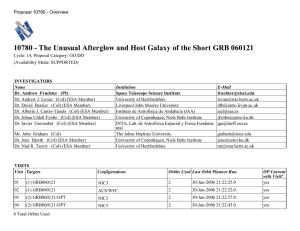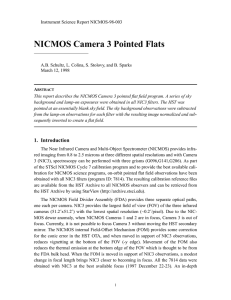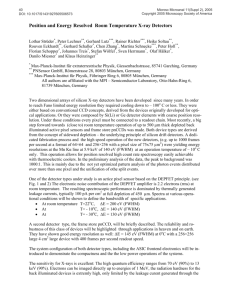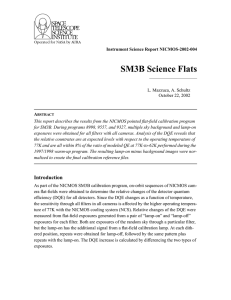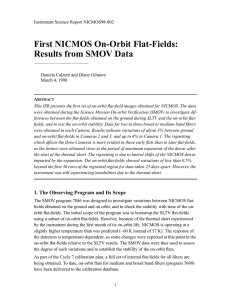Camera 3 Performance
advertisement
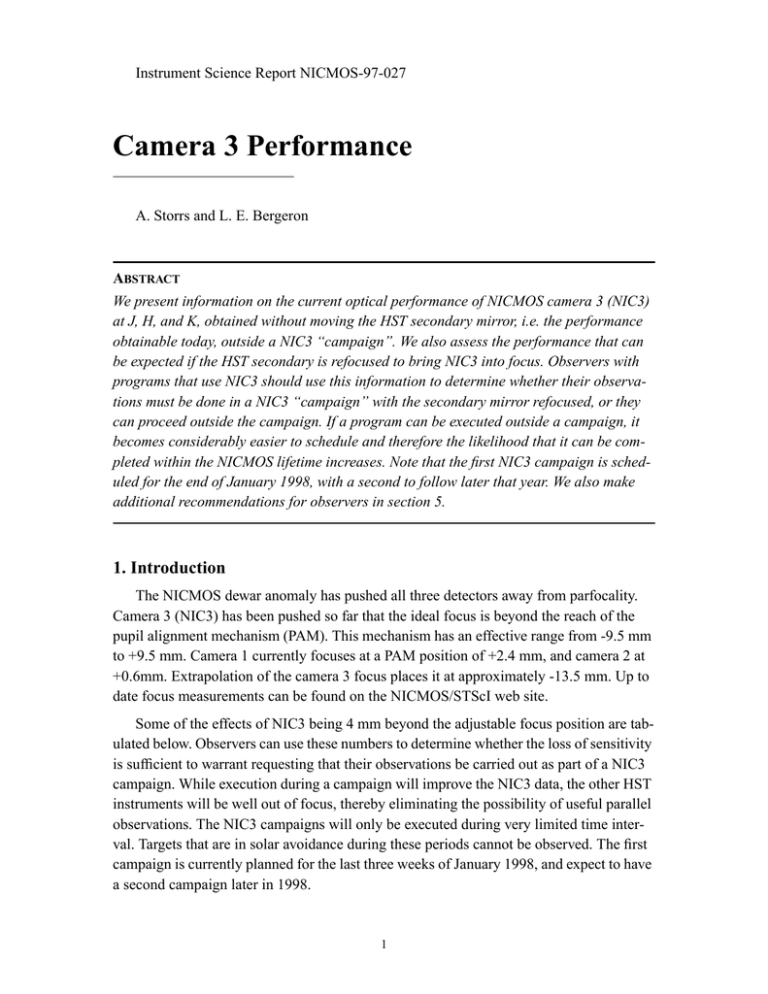
Instrument Science Report NICMOS-97-027 Camera 3 Performance A. Storrs and L. E. Bergeron ABSTRACT We present information on the current optical performance of NICMOS camera 3 (NIC3) at J, H, and K, obtained without moving the HST secondary mirror, i.e. the performance obtainable today, outside a NIC3 “campaign”. We also assess the performance that can be expected if the HST secondary is refocused to bring NIC3 into focus. Observers with programs that use NIC3 should use this information to determine whether their observations must be done in a NIC3 “campaign” with the secondary mirror refocused, or they can proceed outside the campaign. If a program can be executed outside a campaign, it becomes considerably easier to schedule and therefore the likelihood that it can be completed within the NICMOS lifetime increases. Note that the first NIC3 campaign is scheduled for the end of January 1998, with a second to follow later that year. We also make additional recommendations for observers in section 5. 1. Introduction The NICMOS dewar anomaly has pushed all three detectors away from parfocality. Camera 3 (NIC3) has been pushed so far that the ideal focus is beyond the reach of the pupil alignment mechanism (PAM). This mechanism has an effective range from -9.5 mm to +9.5 mm. Camera 1 currently focuses at a PAM position of +2.4 mm, and camera 2 at +0.6mm. Extrapolation of the camera 3 focus places it at approximately -13.5 mm. Up to date focus measurements can be found on the NICMOS/STScI web site. Some of the effects of NIC3 being 4 mm beyond the adjustable focus position are tabulated below. Observers can use these numbers to determine whether the loss of sensitivity is sufficient to warrant requesting that their observations be carried out as part of a NIC3 campaign. While execution during a campaign will improve the NIC3 data, the other HST instruments will be well out of focus, thereby eliminating the possibility of useful parallel observations. The NIC3 campaigns will only be executed during very limited time interval. Targets that are in solar avoidance during these periods cannot be observed. The first campaign is currently planned for the last three weeks of January 1998, and expect to have a second campaign later in 1998. 1 2. Expected performance The following tables show the performance expected if the HST secondary is refocused so that NIC3 focuses at the given point in PAM units. Note that the plan for the first campaign is to refocus HST to bring the NIC3 focus to -9.5 mm. The numbers in these tables were determined using Tiny Tim point spread functions. These have given an excellent match to the observed performance. The Full-Width at Half Maximum (FWHM) of the PSF given in the next two tables is that for a single image-- effectively it is the theoretical PSF convolved with the 0.2 arcsec pixel. This explains why there is little change of the FWHM with focus-- most of the FWHM given in the next two tables is due to the pixel undersampling the PSF, and not to intrinsic changes in the PSF itself. Table 3 summarizes the diffraction-limited performance. Observers should note that these latter values may only be attained by dithering and image reconstruction, on images with high signal-to-noise ratios. The energies in the peak pixel, and to the first minimum, in the PSF are relative to the in-focus value (-9.5 mm in PAM units). For 1.1 µm, the first minimum is a half a pixel from the peak so the numbers in these columns are the same. Ideally, 52% of the energy falls in the peak pixel at 1.1 µm, and 48% at 1.6 µm. 55% of the energy is within the first minimum at 1.6 µm. The spatial resolution is determined by the separation of two equal point sources in a single image necessary to satisfy the Rayleigh criterion, that is, the minimum in between the two sources is 81% of the peak value. A more liberal criterion (e.g. Sparrow’s criterion of having no minimum between the two peaks) may also be used. In fact, if a series of images each with adequate signal-to-noise are made with telescope motions (dithering) between each image, the image brightness distribution can be reconstructed at improved spatial resolution. (Note that NIC3 is nominally diffraction limited at K but is substantially undersampling H and J). The first two tables give the performance for a single non-dithered image, and the third gives the theoretical limits if NIC3 was critically sampled. It may be possible to improve resolution somewhat by dithering and drizzling, but it is not possible to reach the diffraction-limited case. The best one can hope to do with dithering is to achieve the resolution of a critically sampled PSF convolved with a kernel the size of a real NIC3 pixel. The spectral resolving power is the ratio of the given reference wavelength to the product of the spatial resolution (in pixels, assuming 0.206”/pix) and the GRISM dispersion (slope) given in table 5.2 of the NICMOS Instrument Handbook for the G141. This is an upper limit, because it assumes that the GRISM line spread function is negligible compared to the point spread function. The different on-orbit thermal environment will cause the GRISM resolution to be somewhat different than the handbook value. 2 Table 1. NICMOS camera 3, J band (1.1 µm). Note that energies are relative to the infocus value at -9.5 mm. Resolutions satisfy Rayleigh’s criterion. Focus: FWHM: Energy Energy Spatial Spectral PAM (mm) (arcsec) in peak pix.: inside 1st min.: resolution: (arcsec) resolving power: -13.4 0.246 73% 73% 0.41 75 -12.5 0.242 75% 75% 0.36 84 -11.5 0.238 90% 90% 0.35 89 -10.5 0.234 100% 100% 0.34 90 -9.5 0.234 100% 100% 0.33 92 Table 2. NICMOS camera 3, H band (1.6 µm). Note that energies are relative to the infocus value at -9.5 mm. Focus: FWHM: Energy Energy Spatial Spectral PAM (mm) (arcsec) in peak pix.: inside 1st min.: resolution: (arcsec) resolving power: -13.4 0.228 67% 74% 0.45 100 -12.5 0.234 86% 84% 0.41 108 -11.5 0.234 96% 93% 0.36 124 -10.5 0.234 100% 98% 0.34 131 -9.5 0.222 100% 100% 0.33 136 Table 3. NICMOS camera 3, theoretical limits given critical pixel sampling with NIC3 infocus at -9.5 mm. The FWHM was measured directly from subsampled TinyTim PSFs, the energies are the same as those presented in the plots below, and the spatial resolution is defined as the measured radius of the first Airy minimum (Sparrow’s criterion) Band: FWHM: Energy Energy Spatial (central wavelength) (arcsec) % of total in peak pixel: % of total inside 1st min.: resolution (arcsec): J (1.1) 0.10 52% 52% 0.11 H (1.6) 0.15 48% 55% 0.17 K (2.2) 0.18 40% 53% 0.22 3 3. Current vs. Expected Performance Presented here are characteristics of the current NIC3 configuration as compared with an optimally in-focus NIC3. Figure 1 shows the measured FWHM in arcseconds as measured from 4x subsampled TinyTim PSFs vs. filter central wavelength, for both the current NIC3 focus (~-13.3 mm PAM) and NIC3 in-focus at -9.5 mm. This is the theoretically achievable FWHM if the PSF were critically sampled in NIC3. See Tables 1 and 2 for a listing of “effective” FWHM in NIC3. The loss of focus in a diffraction limited image does not change the FWHM much. It primarily causes a redistribution of energy from the inner core of the PSF to the outer rings. Figure 1. Theoretical NICMOS FWHM assuming critical pixel sampling. Dashed line is defocused by 3.8 mm (i.e. current), solid line is in focus. Figure 2 shows the peak pixel energy vs. wavelength, and figure 3 shows the core energy vs. wavelength. The PSF core is defined by the first Airy minimum, which moves outward (i.e. gets bigger) towards longer wavelengths. NIC3 Peak Pixel Energy 0.60 Energy in Peak Pixel (% of total) 0.50 0.40 0.30 0.20 bergeron Fri Oct 17 12:56:29 1997 0.10 0.00 1.0 1.5 2.0 Central Wavelength (Microns) 2.5 Figure 2. NIC3 peak pixel energy vs. wavelength. Dashed line is current (-13.3 mm) focus, solid line is in focus at -9.5 mm. NIC3 Core Energy bergeron Wed Oct 1 20:12:03 1997 Energy Inside First Airy Minimum (% of total) 0.60 0.50 0.40 0.30 0.20 0.10 0.00 1.0 1.5 2.0 Central Wavelength (Microns) 2.5 Figure 3. NIC3 core energy vs. wavelength. Dashed line is current (-13.3 mm) focus, solid line is in focus at -9.5 mm. The core is defined to be the area inside the first Airy minimum, which gets larger towards longer wavelengths. 5 4. Energy Tables Here we present a set of tables of fractional energy in a 5x5 pixel box centered on the J, H, and K PSFs at both the current -13.3 mm focus setting, and for an in-focus “campaign mode” focus at -9.5 mm. All of these are assuming FOMYPOS=16 (see section 5 below). The PSF has a slightly different shape at FOMYPOS=0 (used in the preceding sections). Table 4. At -13.3 mm focus (percent of total energy): J (1.1) H (1.6) K (2.2) 0.2 0.3 0.4 0.3 0.2 0.2 0.3 0.6 0.5 0.2 0.2 1.0 1.2 1.0 0.6 0.4 2.4 4.5 4.7 0.7 0.8 2.9 3.6 4.3 1.2 1.2 2.3 4.5 3.1 1.6 2.0 9.5 30 11 1.4 2.0 6.4 34 7.3 1.8 2.0 5.4 32 6.2 1.9 1.3 6.3 6.1 3.1 0.5 1.6 5.6 4.0 3.7 0.8 2.0 3.8 3.8 2.9 1.4 0.4 0.7 1.2 0.5 0.2 0.5 0.9 1.1 0.6 0.2 0.6 1.4 1.6 1.2 0.2 Table 5. At -9.5 mm focus “Campaign mode” (percent of total energy): J (1.1) H (1.6) K (2.2) 0.2 0.2 0.2 0.3 0.2 0.2 0.3 0.3 0.1 0.2 0.2 1.0 1.1 0.5 0.1 0.3 1.7 4.5 1.1 0.4 0.2 2.7 4.9 1.9 0.2 0.7 2.6 5.9 2.1 0.9 0.5 7.9 49 4.8 0.3 0.5 5.8 46 4.6 0.3 1.7 5.0 37 5.3 1.3 0.6 2.7 10 2.8 0.3 0.4 4.7 6.7 4.5 0.1 1.2 3.9 5.0 3.6 1.0 0.3 0.4 0.8 0.5 0.2 0.3 0.3 1.0 0.6 0.1 0.1 1.1 2.0 1.3 0.2 5. Additional Considerations Observers who want their NIC3 observations done outside of a campaign should keep in mind a few more potential problems. Here we discuss “bars”, vignetting, and calibration problems and how to overcome them. 6 Observers should note that images obtained when one or more NICMOS cameras are in “autoflush” mode are prone to an effect called “bars”. These bars are rows or columns of 2-3 pixels width that have increased noise. While this effect can be partially compensated in data reduction, the effect can be eliminated by running all three cameras. Even though they may be out of focus, observers should include NIC1 and NIC2 in parallel to their NIC3 primary images. We recommend using a SPARS sequence to minimize data buffer dumps, and use of the F237M filter on NIC2 to allow for continued monitoring of HST’s thermal emission. Here is an example of a NIC3 observation with parallel NIC1 and NIC2 observations. 7 The following image shows horizontal “bars” in each NIC3 quadrant, as well as the different bias level in each quadrant caused by either the “pedestal effect” or a bad dark frame (good darks should be available by the campaign). “bars” “cold” vignetting Another consideration for observers before the campaign is the correction for “warm” vignetting (see NICMOS Handbook). This is done by moving the Field Offset Mechanism (FOM) using the exposure level optional parameter FOMYPOS=16. This correction will be done automatically for observations for which NIC3 is prime (or the first NICMOS parallel with another instrument prime) after Dec. 29, 1997. Before this time, observers must state the parameters below explicitly and hence, cannot use “canned” dither/chop patterns on these observations. See program 7806 for an example. A final minor consideration is that camera 3 calibrations will be fine-tuned for the campaign(s) as well. Observers may wish to discuss the impact of executing their observations outside of a campaign with their CS. 8
